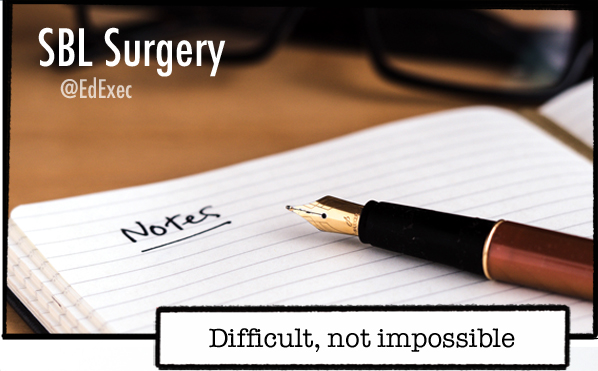In all the roles I’ve had in education in the last decade, I’ve led on recruitment. I’ve recruited Executive Leaders, Headteachers, Senior Leaders, Support Staff and temporary staff.
Whilst the roles and job descriptions vary, the application process does not. I must have read thousands of application forms over the years and whilst some have been amazing and even a pleasure to read, many have had me banging my head off the desk.
If you’re considering applying for a new job or are in the process of writing an application, then this blog post is for you.
Here are my top 7 tips for writing a quality application. By taking note of these, not only will you increase your chances of getting an interview, you will also help those who manage recruitment in schools and MATs stay sane!
1. Do your research
Before you start writing your application, ensure that you:
- Read the advert, job description and person specification carefully and thoroughly
- Look at the website to learn more about the organisation
- Research the structure of the organisation and the governance arrangements
- Check the latest Ofsted report and performance tables
- Google the name of the organisation (and its leader) and see what comes up
- Research the community they serve as well as their partnerships, collaborations and affiliations with other stakeholders
All of the above will help you to understand the organisation you’re applying to work for as well as where your role fits in the broader picture.
2. Arrange a visit
Visit the organisation before you submit your application. This is especially important for leadership roles. It may save you time in the long run and you will learn so much. Before your visit, make sure you use your research to draft some questions to ask when you’re there. The aim of a visit is to find out more about the organisation as well as see what it’s like in action. Is it somewhere you can see yourself working? What are the people like? How does it feel? If you don’t like it, you’ve not wasted your time writing an application. If you do like it, the insights you gain will help you to write a stronger application. Win-win!
3. Do exactly what you’re asked to do
Wherever there is a box on an application form, always write something in it; even if it’s N/A. It shows that you’ve read the form thoroughly and it doesn’t leave recruiters wondering if you left a box blank accidentally. If they ask for online applications, submit it online – don’t post it. If they specify a format for an answer, use it. If they ask you to keep your answers to a specific length, do it. By completing the application correctly, you’ll not only demonstrate your ability to follow instructions but also the recruiter will be very grateful!
4. Personalise it
Filling out applications is time-consuming. The education sector does not do enough to make it easy to apply for jobs, especially if you are applying for multiple jobs simultaneously. This is why you need to be savvy in terms of personalisation and structure. All recruiters have to judge you on at this stage, is what you write on that application so, as small as these things may seem, they matter a lot. Recruiters will make a judgement about you if you address your application to the wrong person or leave in references to the last organisation you applied to. When recruiters read your application, you want them to feel that you’re invested in getting this job, not just a job. It’s harsh but it’s true; if you slip up on this one or you write an application that is clearly copied and pasted (they can tell), then you could be bumped down the shortlist.
5. Structure it
Recruiters learn the most about applicants from their ‘personal statement’. The first few pages of the form are to check that you meet the basic requirements in relation to education, qualifications and suitability. The personal statement is what truly differentiates you as a candidate and can be the difference between your application being selected or tossed to the side.
Make sure that your personal statement:
- Outlines your knowledge, skills and experience in a way that directly relates to the role and person specification – before you start writing, map out the criteria and write some bullet points for each area to ensure that you don’t miss anything
- Is written in a way that is easy for recruiters to tick off the criteria listed in the person specification – they don’t want to spend time hunting through pages and pages of narrative. They shouldn’t have to try to figure out whether what you’re saying matches the person they are looking for. You should make it abundantly clear. (Also, if you structure your personal statement carefully, you’ll find it easier to personalise and edit it for other applications)
- References your experience explicitly and specifically – some applicants think that it is enough to say that they meet the criteria without demonstrating how, or fill the page with broad, vague statements. Be specific about what you’ve done, how you did it and what impact you had so there is no room to question your expertise or credibility as a candidate.
- Uses your research to best effect – whilst maintaining your focus on the role you’re applying for, look for ways to incorporate other skills and experience that may be relevant but not explicitly referenced on the person specification. If you know that literacy is an issue and you have previously led a successful reading initiative, then talk about it. If you know that finance is an issue and you’ve got experience in bid writing or fundraising, talk about that too. This attention to detail and ‘marrying’ of your skillset with their needs will help to set you apart from other candidates and make you more memorable. Just be mindful not to get too carried away or stray too far from the core role.
6. Express yourself appropriately
When we read personal statements, we want to get a feel for what you’re like as a person. But remember, there is a fine line between showing personality and showcasing yourself like you’re on a shopping channel. Keep adjectives to a minimum, don’t use slang and don’t go off on a tangent. Be enthusiastic, confident and specific. It can be tempting to throw everything at it but hold something back for the interview. You want recruiters to read your application and see not only that you are appropriately qualified and experienced but that you’re an interesting person that they’d like to find out more about.
7. Proofread it
Recruitment season gets crazy I know, but try and give yourself at least enough time to write your application and put it away overnight before proofreading and editing. When you stare at something for too long, you lose your objectivity and typos, missing words and rogue capitalisation can slip past you. Read your application out loud to yourself – maybe even record yourself reading it. This way, you can catch any awkward sentence structures and disjointed statements. If you feel comfortable and you have time, ask someone else to proofread it for you, not only to make sure you haven’t missed anything obvious but also to give you some objective feedback.
This blog is part of a series – to read my other posts about how to decide if you’re in the right job, mapping your career path, choosing the right CPD and how to make a good impression at interview, click here.
Like what you’ve read? Subscribe to this blog by clicking here.
P.S. Have you joined The Business of School Leadership Facebook Group yet? For practical support, advice, tips, tools & guidance about all things school leadership, join us in the community by clicking here.




